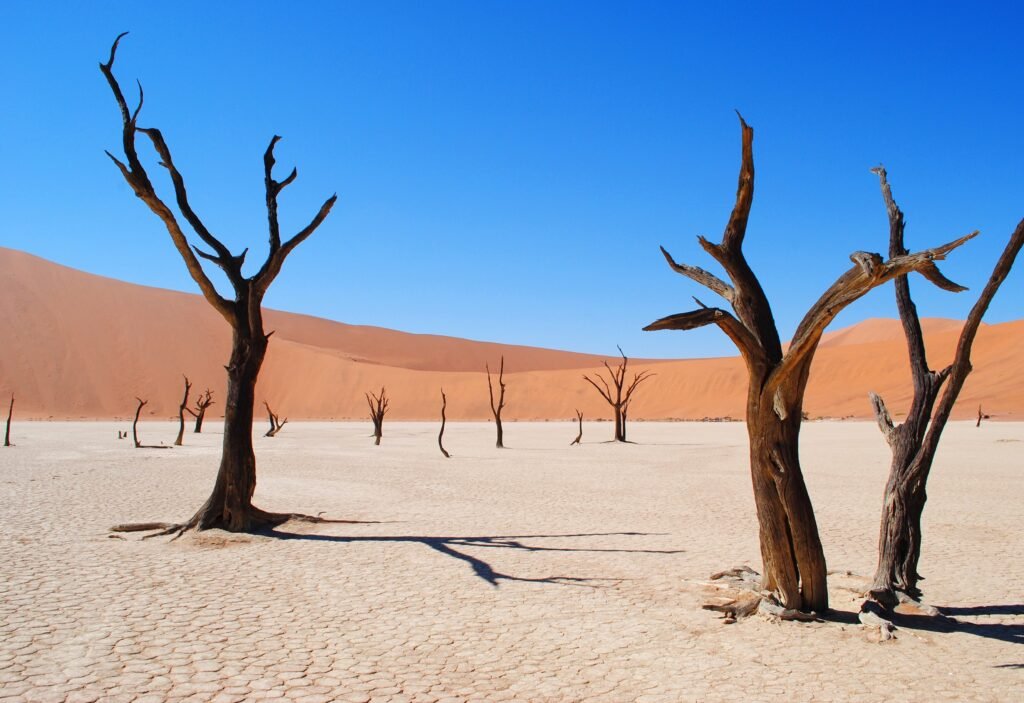Deserts are often overlooked by nature photographers who chase lush greenery or dramatic coastlines. But deserts possess a unique, stark beauty—offering wide-open skies, shifting sands, rugged rock formations, and vibrant color contrasts that tell stories of resilience and time.
In this blog, we explore the most stunning desert landscapes around the world for nature photography, from golden dunes to alien-like rock formations.
1. Sahara Desert, Morocco
The Sahara is the world’s largest hot desert and a dreamscape of towering dunes, golden light, and endless horizons.
Why Photographers Love It:
- Rippling sand dunes with changing patterns throughout the day.
- Vibrant sunsets and star-filled skies.
- Camel caravans and Berber camps create timeless, human elements.
Pro Tip:
Use early morning or late afternoon light to capture soft shadows and beautiful dune textures.
2. Namib Desert, Namibia
The Namib is one of the oldest deserts on Earth, renowned for its vibrant red dunes and unique dead tree forests.
Why Photographers Love It:
- Deadvlei’s skeletal camel thorn trees against stark white clay pans.
- Dunes of Sossusvlei glowing deep orange at sunrise.
- Contrasting colors and endless minimalist compositions.
Pro Tip:
Use a telephoto lens to compress layers of sand dunes for striking geometric patterns.

3. Atacama Desert, Chile
Known as the driest desert on Earth, the Atacama offers surreal, Mars-like landscapes.
Why Photographers Love It:
- Salt flats, wind-sculpted rock formations, and pink flamingos.
- Valle de la Luna (Moon Valley) offers dramatic sunset scenes.
- Crystal-clear skies perfect for astrophotography.
Pro Tip:
Capture the Milky Way over desert backdrops from March to October for perfect night skies.
4. Wadi Rum, Jordan
Wadi Rum is often called the “Valley of the Moon,” with massive sandstone mountains rising from red sands.
Why Photographers Love It:
- Towering rock bridges, narrow canyons, and ancient petroglyphs.
- Golden light illuminating the red sandstone formations.
- Bedouin culture and camel silhouettes create powerful compositions.
Pro Tip:
Stay overnight in a Bedouin camp for the chance to capture the desert under the stars.
5. White Desert, Egypt
The White Desert is one of the world’s most unique landscapes, with chalk rock formations shaped by centuries of wind erosion.
Why Photographers Love It:
- Ghostly, surreal shapes like mushrooms and animals.
- Soft, white sand creating minimalist, high-contrast scenes.
- Vivid sunsets casting golden hues on the pale landscape.
Pro Tip:
Sunrise and sunset offer the best light to bring out texture and shadows in the white formations.
6. Death Valley, California, USA
Death Valley is the hottest place on Earth, yet it offers incredible variety for nature photographers.
Why Photographers Love It:
- The rippled sand dunes of Mesquite Flat.
- Badwater Basin’s unique salt patterns.
- Zabriskie Point’s golden ridges at sunrise.
Pro Tip:
Bring a wide-angle lens to capture the vastness, and explore early mornings to avoid extreme heat.
7. Gobi Desert, Mongolia
The Gobi offers a blend of rolling dunes, rocky outcrops, and rich cultural experiences.
Why Photographers Love It:
- Golden dunes interspersed with green steppe landscapes.
- Bactrian camels, eagle hunters, and traditional yurts.
- Fossil-rich areas and dramatic desert cliffs.
Pro Tip:
Summer offers milder temperatures and beautiful sunsets over the dunes.
Essential Tips for Desert Photography:
- Timing is key: Shoot during the golden hours to soften harsh light and highlight sand textures.
- Mind the elements: Protect your gear from sand with sealed bags and covers.
- Use polarizers: Enhance blue skies and reduce glare on bright sand.
- Capture patterns: Wind-sculpted ripples and layered dunes make striking abstract shots.
Deserts are anything but empty. They are rich with texture, light, and subtle life, offering countless opportunities for creative compositions.
Their silence and simplicity challenge photographers to find beauty in minimalism and vastness.

































